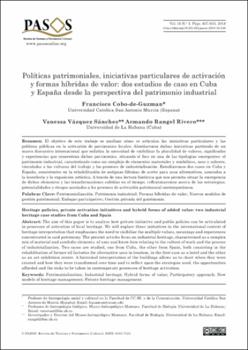Políticas patrimoniales, iniciativas particulares de activación y formas híbridas de valor: dos estudios de caso en Cuba y España desde la perspectiva del patrimonio industrial
Date
2018Abstract
El objetivo de este trabajo es analizar cómo se articulan las iniciativas particulares y las
políticas públicas en la activación de patrimonios locales. Abordaremos dichas iniciativas partiendo de un
marco discursivo internacional que enfatiza la necesidad de visibilizar la pluralidad de valores, significados
y experiencias que concentran dichos patrimonios, situando el foco en una de las tipologías emergentes: el
patrimonio industrial, caracterizado como un complejo de elementos materiales y simbólicos, usos y saberes,
vinculados a las culturas del trabajo y los procesos de industrialización. Estudiaremos dos casos en Cuba y
España, consistentes en la rehabilitación de antiguas fábricas de aceite para usos alternativos, asociados a
la hostelería y la exposición artística. A través de una lectura histórica que nos permita situar la emergencia
de dichos elementos y las transformaciones sufridas en el tiempo, reflexionaremos acerca de las estrategias,
potencialidades y riesgos asociados a los procesos de activación patrimonial contemporáneos. The aim of this paper is to analyse how private initiative and public policies can be articulated
in processes of activation of local heritage. We will explore these initiatives in the international context of
heritage interpretation that emphasises the need to visibilise the multiple values, meanings and experiences
concentrated in said patrimony. The present articles focus on industrial heritage, characterised as a complex
mix of material and symbolic elements, of uses and know‑how
relating to the culture of work and the process
of industrialization. Two cases are studied, one from Cuba, the other from Spain, both consisting in the
rehabilitation of former oil factories for alternative uses in tourism, in the first case as a hotel and the other
as an art exhibition centre. A historical interpretation of the buildings allows us to chart when they were
created and how they were transformed over time and to reflect upon the strategies used, the opportunities
afforded and the risks to be taken in contemporary processes of heritage activation.





